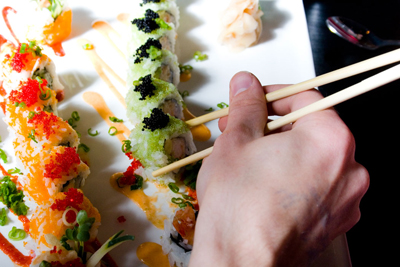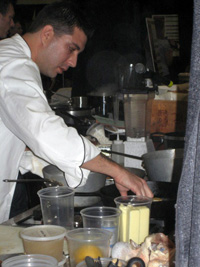 |
|

| Aged to Perfection |
| Pop Art |
| Bottling Up Success |
| Edible Art |
Edible Art: Wisconsin Chefs Create Masterpieces in the Kitchen |
||||||||||||
| Amanda McGowan | ||||||||||||
Imagine. A fresh, clean plate in front of you. First, you pool the deliciously savory sauce at the base of the plate, its dark brown color sharply contrasting the bright white plate. Then, add the fresh, steamed–yet still crisp–vegetables: peppers, beans, corn, all locally grown. The rainbow of the Wisconsin-grown produce looks
vibrant atop the brown sauce, making the white edges of the plate pop. Next, add the centerpiece–a perfectly grilled, medium-rare steak with a pink and slightly cool center, browned and steaming on the outside. The grill lines are fresh, and the meat’s natural juices are oozing out, mixing with the sauce and vegetables to create a tantalizing aroma and impeccable taste. Top the dish off with a little green garnish, and it’s ready to eat. You dig the steak knife into the meat and cut off your first bite. Now on your fork, you take the piece and roll it around the plate, soaking in the sauce and catching vegetables along the way. You bring the piece up to your mouth, about to indulge in this brown, yet bright, chewy, sauce-smothered concoction that will satisfy a growling stomach and craving taste buds. Did you see it? If your mouth is drooling and your stomach churning hungrily, you pictured what Leonardo Guevara, executive chef at Restaurant Magnus, sees at the grocery store, shopping for different vegetables and meats while thinking of how to combine and use them. You visualized dinner. Visualizing how a dish will look and then creating it into a tasty masterpiece makes cooking an art form. Chefs, as artists, combine flavors, colors, textures and ingredients to create dishes that not only taste delicious, but also engage diners in a sensory experience. Through their cooking, Wisconsin’s chefs explore the art of visual taste and provide diners with an artistic experience in every bite. The Art of Taste: “100 percent, hands down flavor”
When Wright opened The Dardanelles 11 years ago, she felt uncomfortable being called “chef” because she lacked formal culinary training. However, she slowly began to realize that not everyone has attended culinary school and many people, like herself, are self-taught. She was finally able to see herself as a chef. She creates art by mixing ingredients, flavors, textures and colors to create food people want to eat. Wright accomplishes her art by looking at a dish from many perspectives. First, she uses the best ingredients she can find–mostly grown on local farms around Madison–and enhances the experience of eating a food in its natural form. “For instance, if you are making a dessert with apples, you want the apples to stand out in the dish. You don’t want to cook them to mush,” Wright said. “The second thing you have to think about is the visceral pleasure of eating it. It’s crunchy. It’s sticky. Is it savory? The things you want people to come away with after they eat the dish.” According to Juan Urbieta, executive chef at Ristorante Bartolotta in Wauwatosa, the key to the art of cooking is learning the basic techniques of mixing the components of food to create a flavorful dish. “For me, the art of cooking is 100 percent, hands down flavor,” Urbieta said. “An artist is somebody who puts their own signature on whatever they’re making. First thing you have to learn is the techniques, you have to learn the basics. You apply the techniques and now you’re ready to create something fun, something cool.” |
||||||||||||
1 | 2 | 3 print this article |
||||||||||||
About Us | Contact Us | Business Partners | Archives | Sitemap
Copyright 2007 Curb Magazine

